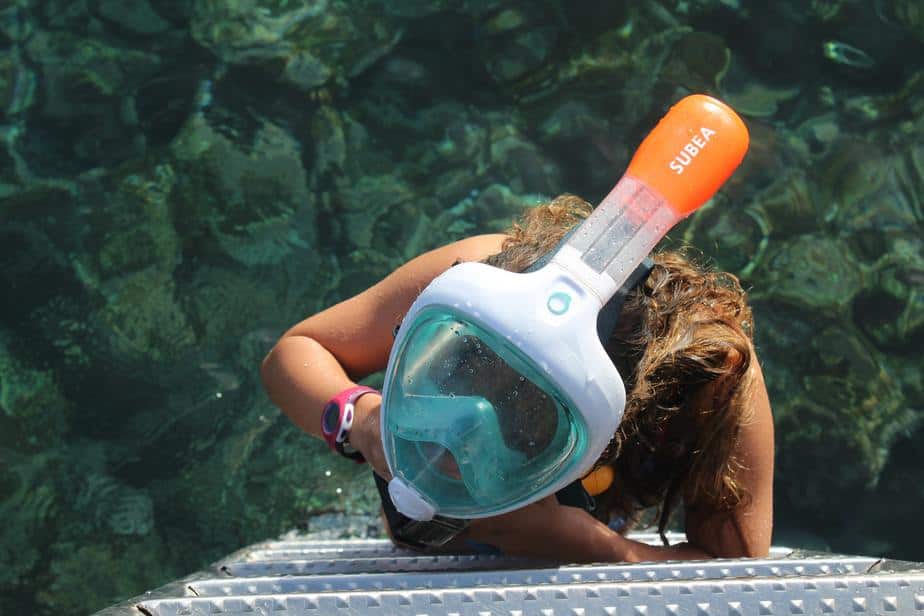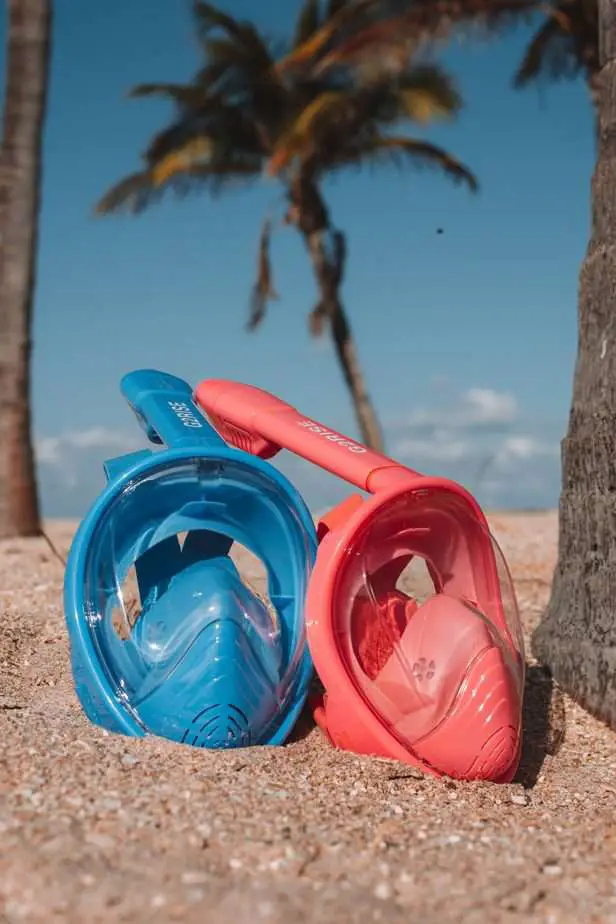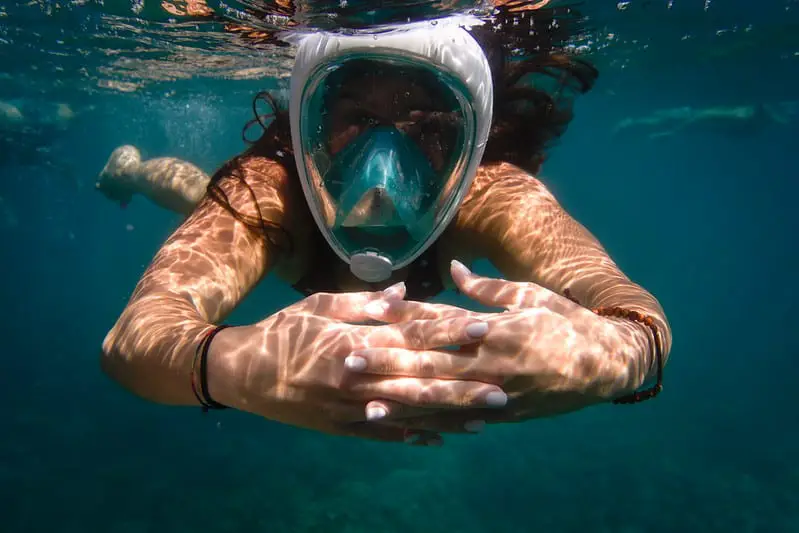When buying a full face snorkel mask, there are many factors to consider (fit being the most important), but a very important one is the quality of the mask lens. The market for snorkel masks has changed significantly since the initial release where your only options were polycarbonate (plastic) lenses or tempered glass.
That said, tempered glass is still the industry standard for traditional snorkel masks, but not necessarily for full face snorkel masks. They provide unbeatable durability for their cost, and that makes them a relatively affordable option that also provides the most safety.
As durable as tempered glass is, it’s not shatterproof. However, their true safety benefit is in how it shatters. Rather than breaking apart into a million smaller, sharp pieces, tempered glass lenses mostly stay together. Full face snorkel masks with plastic lenses, on the other hand, are not optimal. They scratch easily, are not as durable, and should only be used in the pool. They are what you’d find from your typical department store masks or a cheap knock-off product.
Given our description of these two products, it’s quite clear that we are heavily biased towards snorkel masks with tempered glass lenses. However, since plastic lenses are even cheaper, you might think there is an argument to be made for getting plastic lenses for those with lower budgets, but we don’t think it’s wise to wear a snorkel mask with plastic lenses.
In this article, we will explain in more detail why tempered glass lenses are the superior choice, even if they are the more expensive option, and why you should always go with a tempered lens whether you’re wearing a traditional mask or a full face mask.
What is tempered glass?
Like how steel can be tempered, glass can also be tempered via chemical and thermal treatments to make them stronger than regular glass.
Specifically, tempering glass causes it to have high compressive stress on the outer surfaces that is simultaneously balanced by the high tensile stress in the body of the glass.
The end result of tempering glass is that it’s very resistant to micro-cracks and crack propagation. In other words, not only is it more resistant to high temperatures and pressure ranges, but when it breaks, its pieces are blunt and mostly stay together instead of shattering into thousands of sharp pieces.
Tempered glass is used in many things, such as car windshields, shower doors, and even some kitchenware. Even when shattered into smaller pieces, they are not at all dangerous to touch and pick up.
Why look for tempered glass in a snorkel or dive mask?

All high quality snorkel masks, full face masks included, will feature a tempered glass face plate or lenses. You don’t need to assume; this feature should be listed on the mask’s packaging or product description page, if not on the mask itself.
If safety is a priority for you, you should always get a mask that has tempered glass lenses. They will last much longer and be able to withstand the wear and tear of pressure changes and routinely getting bumped, packed, and cleaned.
As mentioned, plastic is much more brittle, offering no protection. Polycarbonate lenses can be easily scratched even just by transporting them. The more scratches there are, the worse your underwater view will be.
Not only that, but plastic lenses cannot be heat treated further to get rid of the residue that is leftover on the lens from the manufacturing process. This is a crucial step in order to prevent your full face mask from fogging up that you simply cannot take advantage of unless your lens is made of tempered glass.
If you’re buying your mask from a generic department store or from a generic online retailer such as Amazon, be very careful what you’re buying. Amazon, for instance, has been flooded with tons of cheap knock-offs that come with plastic lenses to keep costs low. Even if they are more expensive, tempered glass lenses are worth the money.
What other types of tempered glass lenses are there?
As mentioned, all quality masks will feature tempered glass lenses. However, some reputable brands have gone above and beyond to add even more features to tempered glass lenses. We will cover these features here.
UltraClear Glass Lenses

UltraClear Glass Lenses are a proprietary design by Atomic Aquatics. They are an optical quality glass that boasts superior clarity thanks to its high light transmission with little to no color distortion.
A standard tempered glass lens only lets through 86% of available light, whereas UltraClear is marketed as allowing up to 92% of light through. This results in increased color vibrancy and a clarity that surpasses a traditional tempered glass lens.
ARC (Anti Reflective Coating) Lenses
ARC is yet another innovative design by Atomic Aquatics. Since 4-14% of light is reflected or “lost” in a traditional lens, ARC was designed to amplify available light before it is absorbed by the surrounding water.
It sounds similar to the UltraClear described above, and apparently it’s better. ARC boasts a 98% transmission of light, compared to the 86% that traditional lenses allow.
By using a multi-layer metal oxide coating process on both sides of UltraClear lenses, more light is able to enter the mask by decreasing light reflections from the surface of the lens (inside and out). The end result is crisper, clearer vision that surpasses even the UltraClear lenses.
You can snorkel with less eye strain, glare, and “ghost” images on the viewing area. It is especially useful during night snorkeling, snorkeling dring low-viz conditions, or for underwater photographers.
Mirrored Lenses
Finally, there are also mirrored lenses. Essentially, they are a one-way mirror where you can see through them but to others looking at you, they see their reflection on your lenses.
This type of lens seems cool but comes with many downsides. First, it increases confrontations with marine wildlife because they don’t know they are seeing a reflection of themself, not a rival.
Furthermore, by obscuring the snorkeler’s eyes, it’s difficult to ascertain a snorkeler’s comfort levels and so help may not be provided when the person who is wearing the mirrored lenses may be panicking.
Parting words
If you had to choose between a plastic lens or a tempered glass lens, you should pick the mask with a tempered glass lens every time.
Tempered glass lenses provide so many benefits, both in terms of safety and enjoyment of the activity, that you would be miserable if you ever used a mask without tempered glass lenses.
They are much more durable and provide superior views, especially if they have been properly pre-treated.
In general, snorkeling equipment is very affordable, and even a high-quality full face mask should not break the bank.
We do not think it’s worth it to try to cheap out and buy a snorkel mask with a plastic lens because it will scratch easily, fog up, and break more easily.
You should highly consider saving up the extra money and get yourself a full face snorkel mask with tempered glass lenses; it is worth every dollar.


